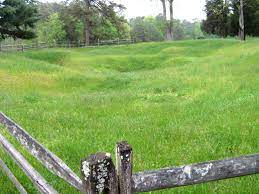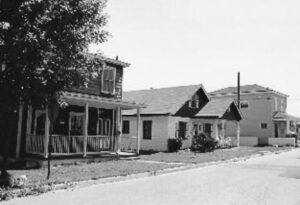Randy Watkins is a former soldier, sailor, police officer, and a few other job titles. He’s a historian with boundless knowledge of times, dates, places and people involved with his beloved Virginia during the Civil War. When I saw his credentials on the webpage for the Ragland Mansion, the B&B where I planned on staying in Petersburg, I contacted him to see about one of his very inexpensive tours. When I asked for an appointment on Saturday, he explained he could not accommodate that, he was part of a Flank March reenactment.
I responded that also sounded interesting; is there any place I could watch a part of it. Not necessary, Randy said, since if you want, you can be part of it.
A seven-mile hike with a dozen or so men all uniformed for the era they were enacting sounded educational and fun, but too tiresome for this octogenarian. Not to worry, Randy said, you can ride in the service vehicle that accompanies it. Then we can do your personal tour on Sunday.
That’s why I enjoyed the best of all worlds for three days in Petersburg, Virginia.
Picking me up at the B&B early Sunday morning, Randy briefly described the city and what we would see; in Civil War time, it was the second largest city in the state, the 7th largest in the Confederacy.
It was important strategically with its location on the south bank of the Appomattox River, at the confluence of the James River, which made it an important site for the North as well in their attempt to take Richmond. It also had five railroads that connected it to Richmond and beyond, making it even more important. Especially to General US Grant in June of 1864 when he was attempting to keep General Robert E. Lee’s troops from Richmond.
So we visited Grant’s headquarters, a gorgeous fertile land right on the river where you can see the James flowing into it. Walking through the grounds filled with buttercups and manicured lawns, now maintained by the National Park Service, you can see the site where Grant’s troops set up their tents, see the cabin he had, the field hospital of the 1860s as well as the magnificent archway of crepe myrtle trees and well-marked signs and spacious acreage. Randy gave a running commentary, also explaining the Petersburg Campaign by the northern General lasted 292 days, ending April 2, 1865, just six days before Lee’s surrender at Appomattox a short distance away.
The house itself, which had been in the Eppes family from the early part of the 18th century, is an example of 18th century Georgian design; it features a three-bay, two-and-a-half story central block design with hipped roof, dormers and flanking one story wings. Well preserved, and open for tours and visitation, we skipped an interior tour in search of other historic sites around the Petersburg area.
Cemeteries always have great stories to tell and sights to see, and we visited one of several in the Petersburg area, all the while Randy pointing out the historical significance of a particular grave or monument.
I learned more about Union General Ambrose Burnside, the son of a former slave owner, a graduate of West Point, and the General in charge for the disastrous Crater, the northern fiasco that took hundreds of lives and led to the General resigning his position shortly after Lee surrendered.
So of course we visited The Crater.
After Union forces descended on Petersburg and Southern forces were defending their city, neither side wanted to face battle. Some of Burnside’s men were Pennsylvania miners and came up with the idea of tunneling underground from behind their own lines to a place underneath where the Confederates were encamped.
The idea was to dig a trench 130 feet long, 60 feet wide and 30 feet deep, then load it with explosives. When they were ignited, the whole thing would blow up, giving the North an underground march to surprise the South. The explosion rocked the area, Northern solders ran into the fume filled crater, Lees’ forces recovered quickly and were prepared to halt the North in its tracks. With volleys from both Southern flanks.

Burnside was relieved of command and was never recalled during the rest of the war. He resigned his position shortly after Lee’s surrender but when on to become Governor of Rhode Island, elected several times.
We visited Pocahontas Island, one of the oldest black communities in the nation, and a city located on the Appomattox River, where 18th century slaves worked in tobacco warehouses.

Today, the area is sparsely inhabited, though it is declared a Historic District and listed on the National Register of Historic places. There is a Black History Museum then that was once a stop on the Underground Railroad.
A few more stops, a lot more stories, and three hours flew by until Randy stopped at the Amtrak station and reminded me, I had a train to catch in ten minutes!
It was homeward bound on Amtrak, and detraining at Metropark, where the jovial Maureen Richardson was waiting to hear my weekend adventures and bring me back to Atlantic Highlands filled with memories of a great weekend in Virginia.
I’m happy you enjoyed and learned the tour. Thanks for the write-up on your visit, the reenactors, and the tour. I apologize for overloading you with details, so I’m not surprised that some things got a little confused, Crater was about 150 X 60 X 30 and tunnel was 510′ 9″. You would have needed at tape recorder to capture all the dates and figures. Anyway, I think you remembered much more than the average visitor to the battlefield. Come again and we’ll do the Western Front of the campaign.